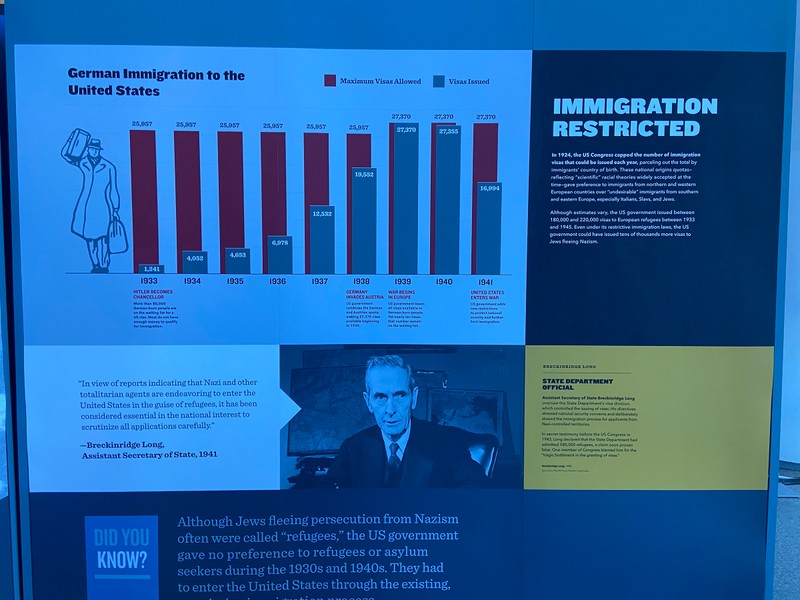Immigration Restricted (Americans and the Holocaust)
Introduction
Author-Uploaded Audio
Immigration Restricted (Americans and the Holocaust exhibit)
Text-to-speech Audio
As you just saw, immigration was a very difficult process. Prospective immigrants seeking to enter the US faced restrictive US immigration laws that set limits on the number of people born in each country who could immigrate every year. The number of visas available per country was based on racist immigration laws established in the 1920s, which gave preference to immigrants from northern and western European countries. Germany was granted the second highest allotment of visas (after Great Britain). For most of the 1930s, 25,957 visas were available every year for immigrants from Germany.
However, you can see on this chart that the State Department did not issue all the visas available under US law until 1939, but by that time, almost 300,000 people, mostly Jews, were on the German waiting list. After World War II began in September 1939, the State Department deliberately began to make immigration even more difficult, claiming that European immigrants—even Jews--might be a threat to national security. In October 1941, Nazi Germany banned all emigration of Jews from its occupied lands.
If you get a chance later, come back and watch the short video on this kiosk, which shows how difficult it was to physically escape Europe after the war began and that fewer ships crossed the Atlantic. The video also tells the story of the St. Louis, a famous ship carrying Jewish refugees that was turned back from Cuba, whose passengers weren’t permitted to enter the United States.
Images
Immigration Restricted panel (Americans and the Holocaust)

Backstory and Context
Text-to-speech Audio
Metropolitan Library System is one of 50 U.S. libraries selected to host AMERICANS AND THE HOLOCAUST, a traveling exhibition from the U.S. Holocaust Memorial Museum that examines the motives, pressures, and fears that shaped Americans’ responses to Nazism, war, and genocide in Europe during the 1930s and 1940s.
The Americans and the Holocaust exhibit will be on display at the Downtown Library, along with a series of related special events from Thursday, January 5 to Sunday, February 12.
Based on extensive new research of that period, Americans and the Holocaust addresses important themes in American history, exploring the many factors — including the Great Depression, isolationism, xenophobia, racism, and antisemitism — that influenced decisions made by the U.S. government, the news media, organizations and individuals as they responded to Nazism. This exhibition will challenge the commonly held assumptions that Americans knew little and did nothing about the Nazi persecution and murder of Jews as the Holocaust unfolded.
Drawing on a remarkable collection of primary sources from the 1930s and ’40s, the exhibition focuses on the stories of individuals and groups of Americans who took action in response to Nazism. It will challenge visitors to consider the responsibilities and obstacles faced by individuals — from Franklin Delano Roosevelt to ordinary Americans — who made difficult choices, sought to effect change, and, in a few cases, took significant risks to help victims of Nazism even as rescue never became a government priority.
Americans and the Holocaust was made possible by the generous support of lead sponsor Jeannie & Jonathan Lavine. Additional major funding was provided by the Bildners — Joan & Allen z”l, Elisa Spungen & Rob, Nancy & Jim; and Jane and Daniel Och. The Museum's exhibitions are also supported by the Lester Robbins and Sheila Johnson Robbins Traveling and Special Exhibitions Fund, established in 1990.
Sources
United States Holocaust Memorial Museum. Accessed January 5th, 2023. https://www.ushmm.org/.
American Library Association. Accessed January 5th, 2023. https://www.ala.org/.
